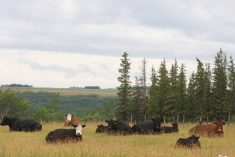I’ve had a hard time getting my morning coffee lately.
The culprit is the multi-buttoned, digital-screened, expensive coffee maker taking up way too much space on the kitchen counter.
Instead of pressing a button, walking away and coming back to a cup of joe, I’m instead greeted with the message “Fill H20,” despite the brimming water reservoir in the back. Unplug the machine. Wait 30 seconds. Plug it back in and try again. On the fifth time, the thing might deign to provide coffee.
Read Also

Roundup retraction makes public trust ripples
A foundational study on glyphosate safety was recently retracted, while Roundup maker Bayer has already said it may ditch the key agricultural herbicide after lawsuits piled up.
The problem, we figure, is the mineral content in the well water that causes problems with the sensors in today’s high-tech, pod-fed coffee machines.
This unit will be the latest in a long line of expensive coffee makers to meet an early grave on the family farm. They’ve each been wonderfully convenient, right up until components start to meet wear and tear. Once that starts, they’re hard to fix and expensive to replace.
It’s a small parallel to farmer stories about equipment sidelined for days, sometimes in the peak windows for harvest or seeding — not because something was mechanically wrong, but because something was wrong with a sensor or computer.
The phrase “right to repair” has been thrown around in countless articles, editorials and even courtrooms, as well as the halls of government in both Canada and the U.S.
This January, John Deere made news when it announced it had signed a memorandum of understanding with the American Farm Bureau Federation on right to repair.
“When we have an issue with a piece of equipment, the computers are the first thing to come out of the technician’s truck, not the wrenches,” then-KAP president Bill Campbell said during the Co-operator’s coverage of that announcement. “If you don’t have access to or the ability to utilize that diagnostic equipment, your right to repair is inhibited.”
RELATED: Right-to-repair advocates fighting, but not gaining much ground
Earlier, in October 2021, an NDP private member’s bill sought to amend Manitoba’s Farm Machinery Act to, among other things, require manufacturers to put the most recent manuals, software updates, parts and tools to diagnosis or repair machinery in farmer’s hands in a reasonably timely fashion. That bill was eventually dropped.
Perhaps equally fraught as right to repair, however, is the ability to repair.
Compared to the cabs in turn-of-the-millennium machinery, today’s combines and tractors might boast multiple screens handling increasingly complicated functions.
Digital technology is a driving force in today’s agriculture. It gives farmers more control of what’s happening in their fields. It helps them gain efficiencies, grow their profit, plan future management and meet growing environmental pressures, including the much discussed 30 per cent reduction in fertilizer emissions.
This is the narrative, and certainly the Co-operator has written many articles on emerging technologies — ranging from increasingly smart sprayers and autonomous equipment to advances in crop monitoring, variable rate application, and more — to be excited about the intersection of agriculture and the digital sphere.
RELATED: Giving Canadians the ‘right to repair’
But with increasing digital reliance comes the need for greater technical know-how on the equipment maintenance side.
Every producer is at least a little bit of a mechanic, but that’s not going to help debug a software problem, even if it wasn’t proprietary. They’ll certainly get better at using the technology, optimizing it, and maybe even finding minor workarounds, but unless every producer starts learning coding as a farm kid, the same way they learned wrenches and grease guns, the increasing digitization of farming will undoubtedly mean more calls to technical support.
If too many of those calls lead to a house call from a tech, that’s an added expense for producers to weigh into their cost of production calculations.
The current discourse around right to repair centres on access and barriers like proprietary technology, but usability is equally important.
If you have the right to repair, but still require constant visits from technicians to fix software issues, how much right do you really have?
















